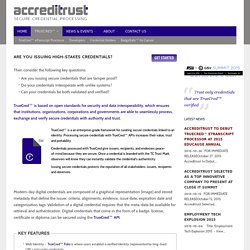

Signaling. Signalling (economics) How much time, energy, or money should the sender (agent) spend on sending the signal?

How can the receiver (the principal, who is usually the buyer in the transaction) trust the signal to be an honest declaration of information? Assuming there is a signalling equilibrium under which the sender signals honestly and the receiver trusts that information, under what circumstances will that equilibrium break down? In the job market, potential employees seek to sell their services to employers for some wage, or price.
Generally, employers are willing to pay higher wages to employ better workers. While the individual may know his or her own level of ability, the hiring firm is not (usually) able to observe such an intangible trait—thus there is an asymmetry of information between the two parties. The paper is concerned with a risk-neutral employer. The differing cost structure need not preclude "bad" workers from obtaining the credential. What Is A Badge? Acclaim. Acclaim's badges are defined and awarded by credible brands and institutions.

Together, we create badges that employers value, verify and trust. Take a closer look at what’s inside an Acclaim badge: 1 The name of the achievement or credential. 2 Describes what the individual is capable of after earning this badge. 3 Outlines the date the badge was issued, who issued it, who it was issued to and when it expires (if applicable). 4 Skills that are represented by earning the badge. Click on skills to view labor market insights data. 5 Lists what it takes to earn the badge. 6 Link to additional information about the badge. 7 If the badge aligns with any industry standards, those standards will be listed here. 8 Optional reference data provides additional context. 9 Hyperlink to optional reference data hosted on an external system. Participating Issuers. Canvabadges. Badge the World. Open Badges: trusted, portable digital credentials, Doug Belshaw. What Gives a Badge Value? What gives a badge value?

As ideas about badges continue to turn into the implementation of badges in various organizations, there continues to be an important conversation about what gives a badge value. There are many ways to approach this conversation, but in most of the conversations, people gravitate toward one of seven answers to this question. Of course, these are not independent of one another. It is certainly possible (in most cases probable) that the answer is a mix of each of these, not to mention perspectives that I did not represent here. Nonetheless, I continue to find it valuable to look at these seven as starting points.
What Gives a Badge Value? Some people look at badges as “micro” credentials. As such, badges don’t often fare well from this perspective because badges don’t have comparable value to degrees in most communities. OER16 – Open… What a distraction twitter is – especially if it means drawing something.

I’ll see something on twitter, have a thought, and before I know it, I’m trying to create that thought. I came across Jim Groom tweeting the title for his keynote at OER16, and I couldn’t resist. “Badge” or “Credential” – What’s in a Name? A lot.

Words are really important. As an advocate for Open Badges to the often unaware, I’ve learned the hard way that I need to be clear about who I’m talking to as I choose my words and the order that I say them. I’m very careful about how I use the word “badges”. Girl Guides of Canada CC-BY I’ll start by saying that the scope of my work up here in Canada goes well beyond K12 and After School programs – I’m also working to convince: Adults (badge earners) that badges will help them advance their careersEducators and trainers (badge issuers) that badges will enhance their brand of learning rather than damage itEmployers (badge consumers) that badges represent a better way to evaluate and map the capabilities that matter to them.
I find it helpful go beyond words and provide visuals like the matrix below, in an effort to avoid simplistic responses (follow the link below if some of it’s hard to read): CAPLA 2015 presentation – Don Presant (slide 22) The “B word”: Help or Hindrance? BadgeSafe™ for Canvas. Secure Credentials. Then consider the following key questions: Are you issuing secure credentials that are tamper proof?

Do your credentials interoperate with unlike systems? Can your credentials be both validated and verified? TrueCred™ is based on open standards for security and data interoperability, which ensures that institutions, organizations, corporations and governments are able to seamlessly process, exchange and verify secure credentials with authority and trust. Modern-day digital credentials are composed of a graphical representation (image) and stored metadata that define the issuer, criteria, alignments, evidence, issue date, expiration date and categorization tags.
Key Features.